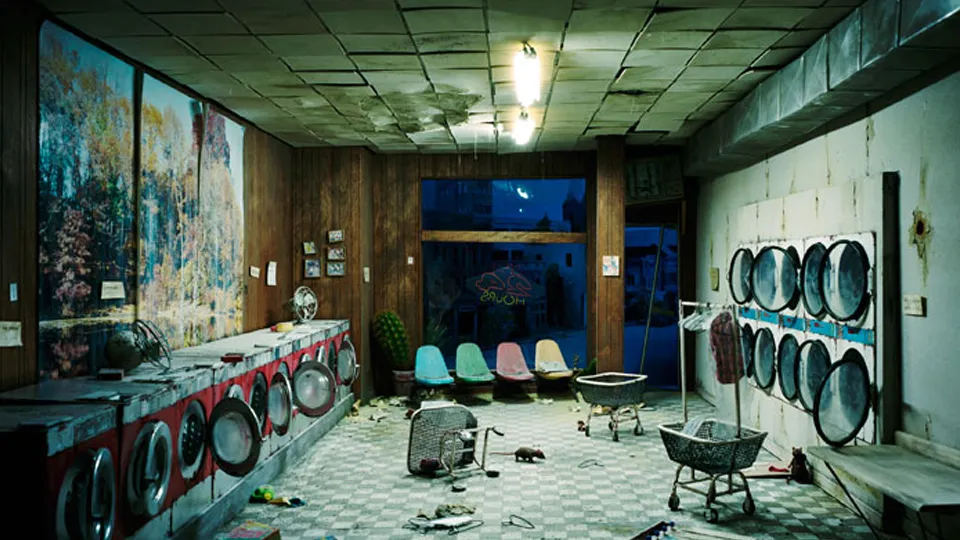In a world stripped of excess, minimalism transforms from aesthetic choice to survival philosophy, revealing unexpected beauty in what remains. 🌿
The concept of aesthetic minimalism takes on profound new meaning when examined through the lens of societal collapse. What was once a trendy interior design movement or lifestyle choice becomes a necessary framework for rebuilding both our physical spaces and psychological resilience. When the structures that once defined modern civilization crumble, those who understand the intrinsic value of simplicity find themselves uniquely equipped to discover meaning, create beauty, and forge new paths forward.
This exploration of post-collapse minimalism isn’t about romanticizing hardship or glorifying deprivation. Rather, it’s about recognizing how constraint can catalyze creativity, how scarcity can sharpen our appreciation for what truly matters, and how the removal of excess reveals the essential elegance that was always hiding beneath layers of consumption and complexity.
🏚️ When Less Becomes More Than Philosophy
The minimalist movement that flourished in the early 21st century emphasized intentionality, mindfulness, and the curated reduction of possessions. Advocates like Marie Kondo asked whether objects sparked joy, while digital minimalists questioned their relationship with technology. These were choices made from positions of abundance—the privilege of having enough to consider what might be too much.
Post-collapse minimalism operates from fundamentally different circumstances. The reduction isn’t chosen; it’s imposed by reality. Supply chains have fractured. Manufacturing has halted. The endless stream of consumer goods has dried to a trickle. In this context, minimalism shifts from aspirational lifestyle to practical necessity.
Yet something remarkable happens in this transition. The forced simplification strips away the anxiety of choice that once paralyzed consumers facing infinite options. The Instagram-perfect aesthetic that required constant curation and updating becomes irrelevant. What emerges instead is a raw, honest relationship with the physical world—one where every object must justify its existence through utility, durability, or genuine emotional significance.
The Psychology of Enforced Simplicity
Human beings possess remarkable adaptability, and our aesthetic sensibilities evolve alongside our circumstances. Research in environmental psychology demonstrates that people quickly recalibrate their baseline for “normal” when external conditions shift dramatically. What initially feels like devastating loss gradually transforms into the new reality against which beauty and comfort are measured.
In post-collapse scenarios, the brain’s reward systems begin responding to different stimuli. The dopamine hit once triggered by acquiring new purchases gets redirected toward successful repairs, discovered resources, or created solutions. The satisfaction of fixing a broken tool with salvaged materials activates the same neural pathways once stimulated by unboxing new gadgets. This neurological reorientation isn’t just about survival—it fundamentally reshapes what we perceive as beautiful and valuable.
🎨 Discovering Beauty in Functional Design
The Bauhaus movement famously declared that form follows function, but this principle achieves its purest expression when resources become scarce. Post-collapse aesthetics naturally gravitate toward designs that eliminate unnecessary ornamentation, not as stylistic statement but as material efficiency.
Consider the beauty inherent in a well-crafted hand tool. The curve of a wooden handle worn smooth by repeated use tells a story of purpose and endurance. The patina on copper cookware speaks to meals prepared and lives sustained. These objects possess an authenticity that mass-produced items, designed for planned obsolescence, could never achieve.
This aesthetic values visible mending, creative repurposing, and the honest display of materials. A shelter constructed from salvaged components becomes a mosaic of survival ingenuity. Clothing patched with contrasting fabrics transforms into wearable narratives. The Japanese concept of wabi-sabi—finding beauty in imperfection and impermanence—stops being exotic philosophy and becomes lived reality.
The Architecture of Necessity
Post-collapse structures exemplify minimalist principles through necessity. Without access to extensive building materials or complex systems, construction returns to fundamental elements: shelter from elements, thermal regulation, structural integrity, and efficient use of available resources.
These constraints produce buildings with striking clarity of purpose. Every wall serves multiple functions. Windows are positioned for optimal natural light and passive heating. Storage solutions integrate seamlessly into structural elements. The result resembles the intentional simplicity of traditional vernacular architecture—buildings that evolved over generations to perfectly suit their environment and available materials.
There’s profound beauty in a structure where nothing is wasted, where every component is essential, and where human ingenuity compensates for industrial capacity. These buildings tell honest stories about the people who created them and the realities they face, achieving an architectural authenticity that eludes much of contemporary design.
♻️ The Renaissance of Repair Culture
Consumer culture positioned broken items as trash and repair as economically irrational—why fix when replacement costs less? Post-collapse reality inverts this calculus entirely. Repair becomes not just necessary but culturally celebrated, elevating skilled craftspeople to positions of respect and influence.
This repair-centric worldview fundamentally alters aesthetic appreciation. The visible mend stops signifying poverty or inadequacy and starts representing resourcefulness and skill. Communities develop repair aesthetics where the quality of a fix becomes a point of pride. The person who can coax another year from failing equipment gains social capital that wealth once conferred.
Knowledge itself becomes minimalist in this context—stripped down to what’s genuinely useful. Theoretical knowledge that can’t be applied holds little value compared to practical skills that solve immediate problems. Educational priorities shift toward hands-on competencies: metalworking, textile production, food preservation, basic medicine, and structural repair.
🌾 Minimalist Food Culture and Foraging Aesthetics
The collapse of industrial agriculture and global food distribution systems forces a return to localized, seasonal eating. The infinite variety of a modern supermarket gives way to what can be grown, foraged, preserved, or hunted within accessible range.
This dietary simplification produces its own aesthetic appreciation. A meal prepared from five ingredients, each harvested within walking distance, possesses an integrity that a complex recipe requiring imported spices never could. The first wild greens of spring or the preservation of summer’s harvest become events worthy of celebration.
Food presentation adopts minimalist principles by necessity. Without access to elaborate serving ware or decorative elements, meals are served on simple plates or even crafted wooden bowls. Yet this simplicity highlights rather than obscures the food itself. A perfectly roasted root vegetable on a plain ceramic plate becomes a study in color, texture, and form—honest and unadorned.
The Social Rituals of Scarcity
Interestingly, material scarcity often enriches social rituals around food. When meals require significant effort to produce, they become focal points for community gathering and gratitude. The aesthetic experience expands beyond visual presentation to encompass the entire context: shared labor in preparation, stories told during consumption, and collective appreciation for sustenance successfully secured.
🧘 Internal Minimalism and Mental Landscape
Perhaps the most profound aspect of post-collapse minimalism occurs in interior psychological spaces. The constant digital stimulation, information overload, and attention fragmentation that characterized pre-collapse life simply cease when infrastructure fails.
Initial withdrawal from this constant connectivity often proves traumatic. People accustomed to perpetual entertainment and communication face uncomfortable silence and their own unmediated thoughts. But those who navigate this transition discover unexpected mental clarity emerging from informational minimalism.
Without algorithmic feeds curating reality, direct sensory experience becomes primary again. The quality of afternoon light draws attention. Changes in weather patterns are observed rather than merely checked on apps. Time dilates when not segmented by notifications and scheduled content consumption.
This mental simplification creates space for deeper contemplation, more authentic emotional processing, and genuine presence in the moment. The aesthetic appreciation of life itself—divorced from its documentation and sharing—becomes possible again. Experience is valued for its intrinsic quality rather than its potential for external validation.
🎭 Art and Expression in Simplified Contexts
Artistic expression continues post-collapse, but transforms in response to material constraints and shifted priorities. Without manufactured art supplies, artists return to fundamental materials: charcoal from fires, pigments from clay and plants, surfaces salvaged from ruins.
These limitations paradoxically liberate creativity. Without access to “proper” materials, experimentation becomes necessary. The distinction between fine art and craft dissolves when both use identical salvaged components. Function and beauty merge as decorated objects must also serve practical purposes.
Music provides perhaps the purest example of post-collapse aesthetic minimalism. Instruments are crafted from available materials or repaired endlessly. Electronic amplification and complex production disappear, leaving only acoustic sound and human voice. Musical traditions simplify, focusing on communal participation rather than specialized performance.
The aesthetic that emerges values authenticity, emotional directness, and communal meaning over technical perfection or innovative complexity. Art serves social and psychological functions that consumer culture once fulfilled: creating shared identity, processing collective trauma, preserving cultural memory, and providing beauty in difficult circumstances.
📚 Information Minimalism and Practical Knowledge
The collapse of digital infrastructure means humanity’s vast accumulated knowledge becomes suddenly inaccessible. What remains are physical books, lived experience, and oral tradition. This creates an enforced information minimalism where only preserved and transmitted knowledge survives.
Communities develop curated collections of essential texts, carefully maintained and studied. Technical manuals on agriculture, medicine, and construction become precious resources. Literary works and philosophical texts that address fundamental human experiences gain new relevance, while much specialized academic knowledge fades into inaccessibility.
This knowledge minimalism produces a surprising benefit: reduced information anxiety. Without awareness of global events or comparison to distant others’ circumstances, communities focus on immediate, actionable realities. The psychological burden of knowing about suffering one cannot affect is lifted. Attention concentrates on the solvable problems within reach.
🏘️ Community Structures and Social Minimalism
Complex bureaucratic structures and institutional hierarchies typically collapse alongside physical infrastructure. What emerges are simplified social organizations built around immediate needs: food production, security, shelter maintenance, and healthcare.
These streamlined social structures eliminate many administrative layers that characterized pre-collapse societies. Decision-making becomes more direct, with fewer intermediaries between problems and solutions. Leadership is earned through demonstrated competence rather than credentialing or political maneuvering.
This social minimalism can feel liberating after the overwhelming complexity of modern institutional life. Roles are clear. Contributions are visible. Social cohesion develops around shared survival challenges rather than abstract ideological alignment. Communities become small enough that every member knows every other, creating accountability and mutual support systems that massive urban anonymity prevented.
⏰ Temporal Minimalism and Natural Rhythms
Without electricity and artificial lighting, human activity realigns with solar cycles. Days begin with sunrise and end shortly after sunset. Seasonal changes dictate available activities—planting in spring, harvesting in autumn, maintenance during winter.
This temporal minimalism eliminates the tyranny of the clock that structured pre-collapse life. Without precise time synchronization requirements, activities flow naturally based on light availability, weather conditions, and task demands. The aesthetic appreciation of time itself shifts from efficiency optimization to rhythmic harmony with natural cycles.
Patience becomes not just virtue but necessity. Growth cycles cannot be rushed. Healing takes time. Construction proceeds at the pace materials and labor allow. This enforced slowness, initially frustrating, gradually reveals beauty in process and duration that rapid consumption culture obscured.
🌟 Finding Meaning in Material Constraint
The ultimate achievement of post-collapse aesthetic minimalism is discovering that material simplicity need not mean impoverished experience. When life strips away consumer abundance, what remains is the capacity for deep appreciation, genuine connection, creative problem-solving, and authentic beauty.
Objects are few but cherished. Experiences are immediate and unmediated. Communities are small but cohesive. Knowledge is limited but practical. Time moves naturally. Beauty appears not in accumulation but in elegant solutions, well-crafted items, and moments of genuine human connection.
This isn’t romanticization of hardship—post-collapse life presents real dangers, deprivations, and suffering. Rather, it’s recognition that human aesthetic sensibilities and meaning-making capacities prove remarkably resilient. Given time to adapt, people find beauty in circumstances that initially seemed devoid of it.
The philosophy of aesthetic minimalism, when tested against genuine scarcity, reveals its deeper truth: beauty never depended on abundance. It exists in proportion, function, honesty, and the human capacity to appreciate what is rather than mourn what isn’t. In simplicity’s embrace, stripped of excess and pretense, the essential elegance of existence itself becomes visible.
Those who cultivate this perspective before necessity demands it gain invaluable psychological resilience. Understanding that satisfaction and beauty exist independent of material abundance provides insurance against circumstances beyond our control. Whether collapse arrives or not, the ability to find meaning in simplicity enriches life immeasurably.
Ultimately, aesthetic minimalism post-collapse isn’t about making do with less—it’s about recognizing that less was always enough. The beauty was never in abundance but in attention, in craft, in purpose, and in the remarkable human ability to create meaning from whatever materials existence provides. 🌸
Toni Santos is a visual explorer and microscopic storyteller who delves into the hidden aesthetics of microbial life. Through a fusion of scientific curiosity and artistic insight, Toni transforms the overlooked world of bacteria, fungi, and cellular forms into mesmerizing visual narratives—revealing the elegance, symmetry, and chaos that thrive at microscopic scales.
Rooted in a fascination with life forms too small to see yet too intricate to ignore, Toni’s work captures the bizarre beauty of microbial colonies, biofilms, and spore patterns. These images aren’t just representations—they are celebrations of the artistic intelligence encoded in nature’s tiniest architects.
With a background in visual design and bio-inspiration, Toni merges scientific imaging techniques with creative expression, transforming petri dish cultures, fluorescence microscopy, and microbial textures into works that provoke both wonder and contemplation.
As the creative force behind Vizovex, Toni offers curated visual studies, microbial-inspired designs, and essays that bridge art and microbiology—inviting viewers to reimagine what beauty means at the edge of perception.
His work is a tribute to:
The hidden geometries of living systems
The surprising elegance of microbial growth
The role of micro-life in shaping visual culture
Whether you’re a scientist, artist, or simply curious about the unseen world that sustains us, Toni opens a window into a universe where life writes poetry in colonies and patterns, one microbe, one frame, one breathtaking detail at a time.





